7th Std Science Lesson Wise Questions in English – Part 1
7th Science Lesson 2 Questions in English
2] Force and Motion
1. The shortest distance from the initial to the final position of an object is called _____
- Projectile
- Velocity
- Transient
- Displacement
Explanation
The shortest distance from the initial to the final position of an object is called Displacement.
2. Which among the following statement is correct
- When an object travels from one place to another, it will reach slower if it travels along the straight-line path. The straight-line path is the longest distance between two points.
- The total length of a path taken by an object to reach one place from the other is called distance.
- Only 1
- Only 2
- Both 1 and 2
- None
Explanation
When an object travels from one place to another, it will reach faster if it travels along the straight-line path. The straight-line path is the shortest distance between two points.
3. What is the SI unit of displacement?
- m
- m/s
- m s-2
- kg/s
Explanation
Both the distance and displacement possess the same unit. The SI unit is meter (m).
4. The path of an object travelling from A to B is shown in figure
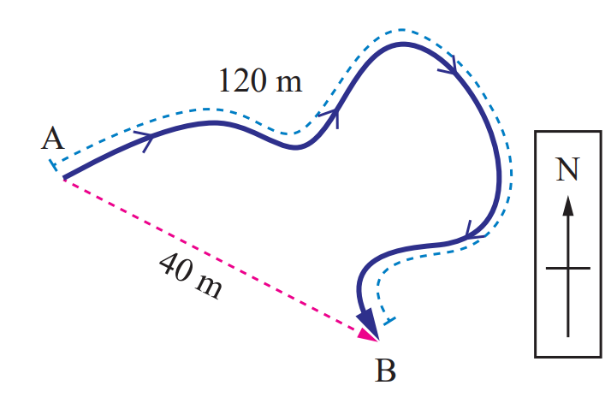
What is the displacement of the object?
- 40 m
- 80 m
- 120 m
- 160 m
Explanation
The path of an object travelling from A to B is shown in figure. Total distance travelled by the object is 120 m. The displacement of the object is 40 m (south-east direction). Here we can consider the starting point as A and while the object moves from A to B the displacement is considered to be positive and from B to A it is negative.
5. Convert 1 km/hr in m/s?
- 2/28 m/s
- 3/19 m/s
- 5/18 m/s
- 7/12 m/s
Explanation
1 km/h = 5/18 m/s
1 km = 1000 m; 1 h = 3600 s
1 km / h = 1000 m / 3600 s = 5/ 18 m /s.
6. Which among the following equation is correct?
- Speed = distance / time
- Speed = time / distance
- Speed = distance × time
- None of the above
Explanation
Speed is the rate of change of distance. Speed = distance /time Unit is metre/second (m/s).
7. Which among the following statement is incorrect
- We can classify speed into two types. If a body in motion covers equal distances in equal intervals of time, then the body is said to be in uniform speed.
- If a body covers unequal distances in equal intervals of time, the body is said to be in nonuniform speed. Average speed = time taken to travel the distance/ total distance travelled.
- Only 1
- Only 2
- Both 1 and 2
- None
Explanation
If a body covers unequal distances in equal intervals of time, the body is said to be in nonuniform speed. Average speed = total distance travelled / time taken to travel the distance.
8. Which among the following equation is correct?
- Velocity = speed × displacement
- Velocity = displacement × time
- Velocity = displacement/time
- Velocity = speed / displacement
Explanation
Velocity is the rate of change in displacement. Velocity (v) = displacement / time.
9. If an athlete in the diagram takes 25 s to complete a 200 m sprint event. Find her speed and velocity.
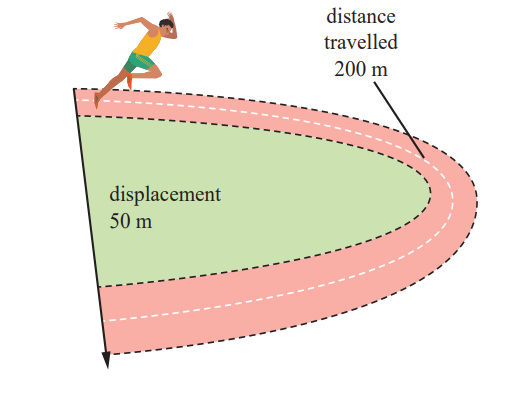
- speed = 8 m/s, velocity = 2 m/s
- speed = 4 m/s, velocity = 2 m/s
- speed = 2 m/s, velocity = 8 m/s
- speed = 8 m/s, velocity = 4 m/s
Explanation
Speed = distance / time = 200 / 25 = 8 m/s
velocity = displacement /time = 50 / 25 = 2 m/s.
10. What is the SI unit of Velocity?
- m
- m s
- m/s
- m/s2
Explanation
SI unit of velocity is meter / second (m/s).
11. A light travels through vacuum is example of which velocity?
- Uniform velocity
- Reverse velocity
- Non-Uniform velocity
- All the above
Explanation
A body has uniform velocity, if it covers equal displacement in the same direction in equal intervals of time. E.g., light travels through vacuum.
12. A train starting and moving out of the station is example of which velocity?
- Uniform velocity
- Reverse velocity
- Non-Uniform velocity
- All the above
Explanation
If either speed or direction changes, the velocity is non uniform. E.g., a train starting and moving out of the station.
13. Which among the following equation is correct?
- Average velocity = total displacement / total time taken
- Average velocity = average displacement / average time taken
- Average velocity = average speed / average time taken
- Average velocity = average displacement / average speed
Explanation
Average velocity = total displacement / total time taken.
14. Figure shows a car that travels 5 km due east and makes a U – turn to travel another 7 km. If the time taken for the whole journey is 0.2 h. Calculate the average velocity of the car.
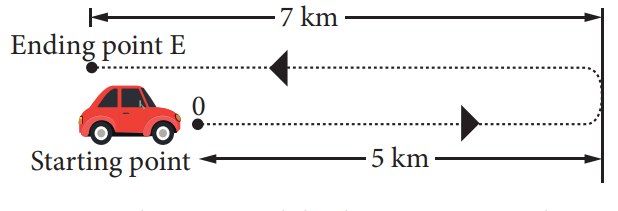
- 0.17 m/s
- 0.28 m/s
- – 0.17 m/s
- – 0.28 m/s
Explanation
Average velocity = total displacement/time taken. (taking the direction due east of point O as positive)
= (5 – 7) / 0.2 = –2 / 0.2
= –10 km/h (or) –10 × 5/18 = 25/9
= – 0.28 m/s
15. Which among the following relation is incorrect?
- v = d / t
- t = d / v
- d = v × t
- None of the above
Explanation
The triangle method can help you to recall the relationship between velocity (v), displacement (d), and time(t). v = d / t, t = d / v, d = v × t.
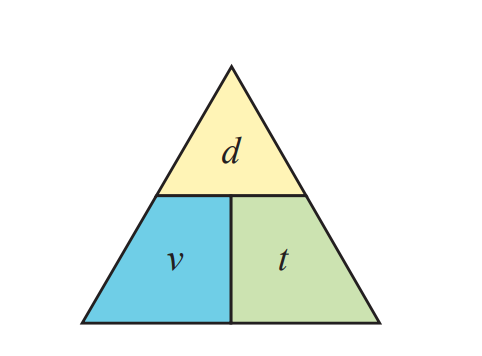
16. Which is the rate of change in velocity?
- Optimization
- Conjunction
- Acceleration
- Polarisation
Explanation
Acceleration is the rate of change in velocity. In other words, if a body changes its speed or dirction then it is said to be accelerated.
17. Which among the following equation is correct
- a = (u–v) / t
- a = (v–u) / t
- a = (v–u) × t
- a = v / (u × t)
Explanation
Acceleration = change in velocity/ time
= [final velocity (v) – initial velocity (u)] / time (t)
a = (v–u) / t.
In other words, the object undergoes acceleration when its speed and/or direction change(s).
18. Which among the following is the SI unit of acceleration?
- m
- m/s
- m/s2
- m s
Explanation
SI unit of acceleration is m/s2.
19. A car at rest starts to travel in a straight path. It reaches a velocity of 12 m/s in 4 s . What is its acceleration. Assuming that it accelerates uniformly?
- 12 m s
- 12 m/s
- 3 m/s
- 3 m/s2
Explanation
Initial velocity u = 0 m/s (since the car starts from rest)
Final velocity (v) = 12 m /s
Time taken (t) = 4 s
acceleration (a) = (v – u) / t
= (12 – 0) / 4
= 3 m / s2
20. If the velocity of an object increases with respect to time, then the object is said to be in ___
- Retardation
- Just acceleration
- Deceleration
- All the above
Explanation
If the velocity of an object increases with respect to time, then the object is said to be in positive acceleration or just acceleration.
21. If the velocity of an object decreases with respect to time, then the object is said to be in ___
- Retardation
- Deceleration
- Negative acceleration
- All the above
Explanation
If the velocity of an object decreases with respect to time, then the object is said to be in negative acceleration or deceleration or retardation.
22. Th e velocity of a golf ball rolling in a straight-line change from 8 m/s to 2 m/s in 10 s. What is its deceleration, assuming that it is decelerating uniformly?
- – 0.6 m/s2
- – 2 m/s2
- 0.6 m/s2
- 2 m/s2
Explanation
Initial velocity (u) = 8 m/s
Final velocity (v) = 2 m/s
Time taken(t) = 10 s
Acceleration (a) = (v – u)/t = (2 – 8)/10 = –0.6 m/s2
The deceleration is –0.6 m/s.
23. Which among the following statement is correct
- An object undergoes uniform acceleration when the change (increase or decrease) in its velocity for every unit of time is the same. When the velocity of the object is increasing by 20 m/s the acceleration is 20 m/s2. When the velocity of the object is decreasing by 20 m/s the deceleration is 20 m/s2.
- An object undergoes non uniform acceleration if the change in its velocity for every unit of time is not the same. Note that the change in velocity is same for every second. The moving object is undergoing non uniform acceleration.
- Only 1
- Only 2
- Both 1 and 2
- None
Explanation
An object undergoes non uniform acceleration if the change in its velocity for every unit of time is not the same. Note that the change in velocity is not the same for every second. Th e moving object is undergoing non uniform acceleration.
24. Which among the following statement is correct based on the graph?
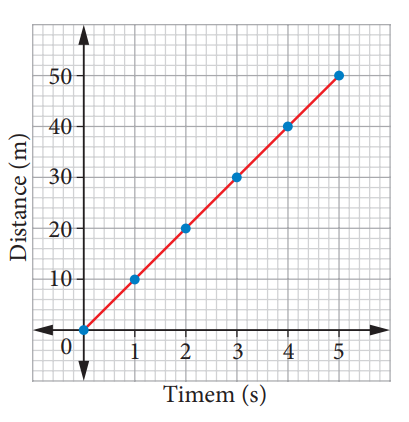
- The graph has zero gradient. The distance is a constant for every second.
- The graph has a zero-constant gradient. The distance increases 10 m every second.
- The graph has an increasing gradient. The speed increases.
- The graph has a decreasing gradient. The speed decreases
25. Which among the following statement is correct based on the graph?
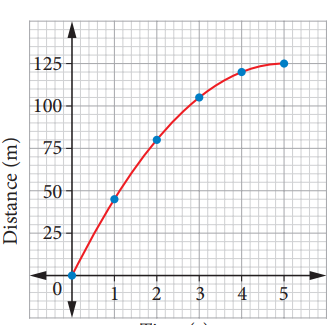
- The graph has zero gradient. The distance is a constant for every second.
- The graph has a zero-constant gradient. The distance increases 10 m every second.
- The graph has an increasing gradient. The speed increases.
- The graph has a decreasing gradient. The speed decreases
26. Which among the following statement is correct based on the graph?
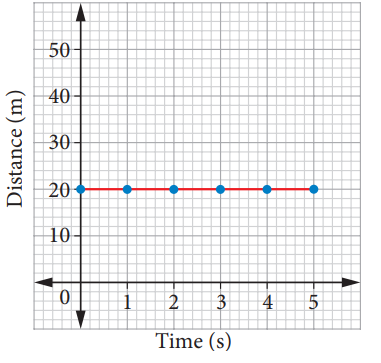
- The graph has zero gradient. The distance is a constant for every second.
- The graph has a zero-constant gradient. The distance increases 10 m every second.
- The graph has an increasing gradient. The speed increases.
- The graph has a decreasing gradient. The speed decreases.
27. Which is the point through which the entire weight of the object appears to act?
- Projectile point
- Centre conjoint
- Centre of gravity
- Centre of active
Explanation
The centre of gravity of an object is the point through which the entire weight of the object appears to act. Try to balance a cardboard on your figure tip. We observe there is only one point which the cardboard is balanced. The point which the cardboard is balanced is called the centre of gravity of the cardboard.
28. Which is a measure of the body’s ability to maintain its original position?
- Stability
- Integrity
- Conductivity
- Capacity
Explanation
Stability is a measure of the body’s ability to maintain its original position.
29. Which among the following is not the type of stability?
- Stable equilibrium
- Unstable equilibrium
- Neutral equilibrium
- Retarding equilibrium
Explanation
The three types of stability are (a) Stable equilibrium (b) Unstable equilibrium (c) Neutral equilibrium.
30. The following image describes which among the following stability?
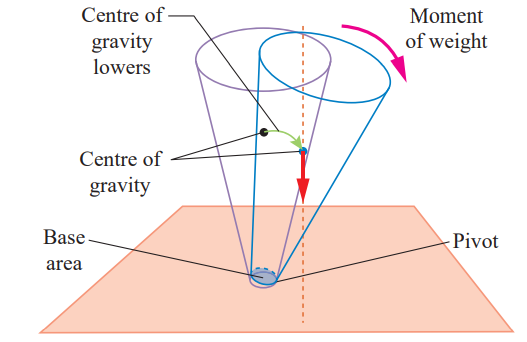
- Stable equilibrium
- Unstable equilibrium
- Neutral equilibrium
- All the above
Explanation
In this unstable equilibrium the frustum will topple with the slightest tilting. Its centre of gravity is lowered when it is displaced.
31. The following image describes which among the following stability?
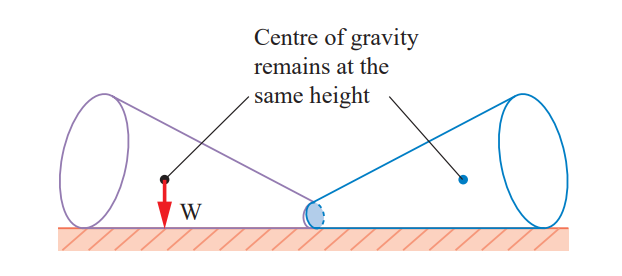
- Stable equilibrium
- Unstable equilibrium
- Neutral equilibrium
- All the above
Explanation
The vertical line through its centre of gravity falls outside its base. It causes frustum to topple. The frustum will roll about but does not topple. Its centre of gravity remains at the same height when it is displaced. Te body will stay in any position to which it has been displaced.
32. The Thanjavur doll is type of traditional Indian toy made of which material?
- Iron
- Copper
- Terracotta
- Ceramic
Explanation
The Thanjavur Doll is type of traditional Indian toy made of terracotta material. Th e centre of gravity and the total weight of the doll is concentrated at its bottom most point, generating a dance-like continuous movement with slow oscillations.
33. Which among the following is not the condition for stability?
- Lower its centre of gravity
- Lower the area of its base
- A heavy base lower at the centre of gravity So the box does not tip over
- A broad base makes the box more difficult to tip over
Explanation
To make a body more stable 1. Lower its centre of gravity 2. Increase the area of its base 3. Th is box is at the point of tipping over 4. A heavy base lower at the centre of gravity So the box does not tip over 5. A broad base makes the box more difficult to tip over.
34. The following image describes which among the following stability?
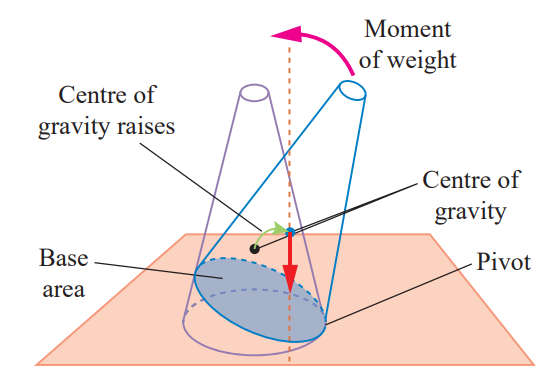
- Stable equilibrium
- Unstable equilibrium
- Neutral equilibrium
- All the above
Explanation
The frustum can be tilted through quite a big angle without toppling. Its centre of gravity is raised when it is displaced. The vertical line through its centre of gravity still falls within its base. So it can return to its original position.